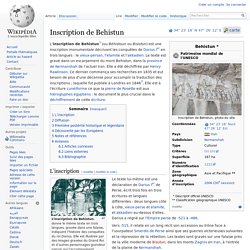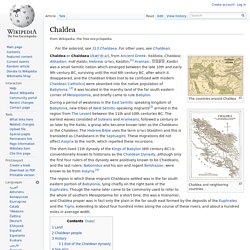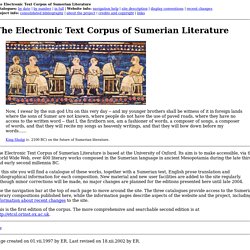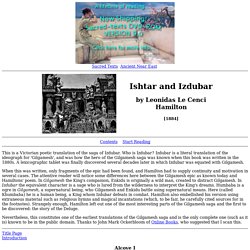

Akkadien. Voici une liste de signes de l'écriture akkadienne utilisés dans le pays d'Akkad à partir de 2300 avant J.

-C. Liste des abréviations: B = Borger BI = Index de Borger d = Différence e = Entrée suiv = Suivant L = Labat LI = Index de Labat LL = Liste de Labat LM = Entrée principale de Labat errimp = Erreur d'impression v = Variante (?) = L et/ou B incertain + = Deux signes en séquence x = Un signe est écrit à l'intérieur de l'autre Les termes en majuscules donnent la valeur logographique du signe. Les logogrammes sont souvent formés de plusieurs signes, la liste des signes formant le logogramme complet est donnée entre parenthèse. Ex. : le signe 468 est utilisé dans le logogramme AZAG, mais ce logogramme est en fait composé de deux signes 468 et 13 donnés entre parenthèses après AZAG, et si on regarde le signe 13 ont retrouvera AZAG dans la liste. Les logogrammes représentent des mots entiers plutôt que des syllabes. Akkad Le royaume d'Akkad La Mésopotamie ancienne Sargon d'Akkad, dit l'Ancien.
ePSD. Inscription de Behistun. Un article de Wikipédia, l'encyclopédie libre.

L’inscription[modifier | modifier le code] L’inscription de Behistun, donne le même texte en trois langues, gravée dans une falaise, indiquant l’histoire des conquêtes du roi Darius. Elle est illustrée par des images gravées du Grand Roi et d’autres personnages grandeur nature qui l’accompagnent. Le texte lui-même est une déclaration de Darius Ier de Perse, écrit trois fois en trois écritures et langues différentes : deux langues côte à côte, vieux-perse et élamite, et akkadien au-dessus d’elles.
Darius a régné sur l’Empire perse de -521 à -486. Vers -515, il relate en un long récit son accession au trône face à l’usurpateur Smerdis de Perse ainsi que ses guerres victorieuses suivantes et la répression de la rébellion. PSD: home page. CDLI - Cuneiform Digital Library Initiative. Chaldea. The countries around Chaldea Chaldea and neighboring countries Chaldea or Chaldaea (/kælˈdiːə/), from Ancient Greek: Χαλδαία, Chaldaia; Akkadian: māt Ḫaldu; Hebrew: כשדים, Kaśdim;[1] Aramaic: ܟܠܕܘ, Kaldo) was a small Semitic nation which emerged between the late 10th and early 9th century BC, surviving until the mid 6th century BC, after which it disappeared, and the Chaldean tribes (not to be confused with modern Chaldean Catholics) were absorbed into the native population of Babylonia. [2] It was located in the marshy land of the far south eastern corner of Mesopotamia, and briefly came to rule Babylon.

During a period of weakness in the East Semitic speaking kingdom of Babylonia, new tribes of West Semitic-speaking migrants[3] arrived in the region from The Levant between the 11th and 10th centuries BC. The earliest waves consisted of Suteans and Arameans, followed a century or so later by the Kaldu, a group who became known later as the Chaldeans or the Chaldees. Land[edit] The Chaldaick Oracles of Zoroaster (Stanley, 1661) This digital edition by Joseph H.

Peterson, Copyright © 1999. All rights reserved. Note: Comments by JHP added in []. The Chaldaick Oracles of And his Followers With the Expositions of Pletho and Psellus Edited and translated to English by Thomas Stanley LondonPrinted for Thomas Dring, 1661 Collected by Franciscus Patricius. Where the Paternal Monad is. The Monad is enlarged, which generates two. For the Duad sits by him, and glitters with Intellectual Sections. And to govern all Things, and to Order every thing not Ordered, Ancient Near East. Sumerian literature: ETCSL: The Electronic Text Corpus of Sumerian Literature. The Electronic Text Corpus of Sumerian LiteratureCatalogues: by date | by number | in full | Website info: navigation help | site description | display conventions | recent changesProject info: consolidated bibliography | about the project | credits and copyright | links Now, I swear by the sun god Utu on this very day -- and my younger brothers shall be witness of it in foreign lands where the sons of Sumer are not known, where people do not have the use of paved roads, where they have no access to the written word -- that I, the firstborn son, am a fashioner of words, a composer of songs, a composer of words, and that they will recite my songs as heavenly writings, and that they will bow down before my words......

King Shulgi (c. 2100 BC) on the future of Sumerian literature. The Electronic Text Corpus of Sumerian Literature is based at the University of Oxford. Use the navigation bar at the top of each page to move around the site. The Behistun Inscription. The Electronic Text Corpus of Sumerian Literature. The Beginnings of the Arsacids - (The Circle of Ancient Iranian Studies - CAIS)© Ancient Iranian Mythology. Ishtar and Izdubar Index. Sacred Texts Ancient Near East Contents Start Reading This is a Victorian poetic translation of the saga of Izdubar.

Who is Izdubar? Izdubar is a literal translation of the ideograph for 'Gilgamesh', and was how the hero of the Gilgamesh saga was known when this book was written in the 1880s. A lexicographic tablet was finally discovered several decades later in which Izdubar was equated with Gilgamesh. When this was written, only fragments of the epic had been found, and Hamilton had to supply continuity and motivation in several cases. Nevertheless, this constitutes one of the earliest translations of the Gilgamesh saga and is the only complete one (such as it is) known to be in the public domain. Title PageIntroduction Alcove I Tablet I--Column I.
Alcove II Tablet V--Column I. ETANA.